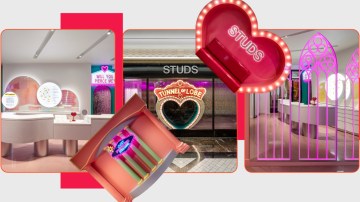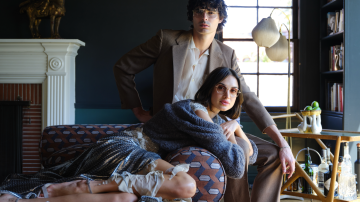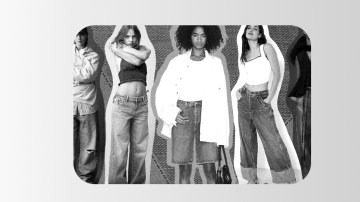In January, Jil Sander revealed its first foray into beauty: Jil Sander Olfactory Series 1, a six-piece fragrance collection designed by the fashion label’s co-creative directors, Luke and Lucie Meier. With eclectic notes like mushrooms and osmanthus, a $290 price point and limited distribution at Jil Sander boutiques, the launch looks more like a niche perfume line, rather than the traditional mass-appealing designer scents found at duty-free stores and department counters around the world.
Jil Sander is far from the only designer perfume launch to take such a strategy in recent months. Balmain and Bottega Veneta both re-entered the perfume category in 2024 with collections of high-priced, limited-distribution scents made in collaboration with the fashion house’s respective creative directors, Olivier Rousteing and Matthieu Blazy. In doing so, those brands are speaking to a growing fragrance audience seeking out unique, bold scents.
Fragrance sales have boomed across markets from mass to prestige in the years since 2020, but it’s the niche brands, with their daring scent profiles and more exclusive positioning, that have particularly captured consumer appetite for innovative smells. Market analysts Circana reported that luxury brands accounted for 12% of all U.S. prestige fragrance sales in 2024 and grew faster than the overall category. Niche brands like Parfums de Marly, which was acquired by Advent International in 2023, and Amouage, of which L’Oréal acquired a minority stake in February, have also posted double-digit growth in recent years.
“What’s happening is this recalibration of how luxury brands are approaching fragrance overall. And it’s in response to the current market and this growing obsession with fragrance, which we have never seen on this level before. The fashion creative director stepping into the fragrance world is like this natural extension of the shift,” said Olya Bar, head of digital strategy and communications at niche fragrance retailer Twisted Lily. “In the past, we had so many designer perfumes that felt like licensing plays. They were very lucrative, but for the most part, they felt very disconnected from the house’s current visual language or ethos.”
But playing in the niche perfume market means competing with brands with a more trusted name in fragrance. And aligning with the fashion house’s branding also means keeping up with a revolving door of fashion creative directors, whose tenures are increasingly unstable. A month after the launch of the Jil Sander fragrances, which were made through a licensing deal with Coty, Luke and Lucie Meier announced their departure from the fashion house. Two months after Bottega Veneta’s $450 perfumes hit the market, Matthieu Blazy ended his tenure at the brand for the creative director role at Chanel.
“With fashion, there’s this fast evolution of preferences and trends and an expectation of just constant evolution. And that’s true in beauty, but not quite the same degree,” said Sherif Guirgis, CEO of specialty beauty retailer Violet Grey. “There may be a huge cohort of customers of a Chanel fragrance or Tom Ford fragrance that, if you changed something, they would actually be furious. There’s the balance of: How do you, on the beauty and fragrance side, stick behind a core that people have clearly demonstrated they love and then build around it?”
Translating a big designer name to a niche fragrance model has been proven to pay off when done well. Victoria Beckham launched her brand’s first fragrance in 2023 with a trio of nearly-$300 scents by perfumer Jérôme Epinette available at select retailers like Violet Grey. The move into fragrance helped the struggling brand boost sales by 50% to £89 million ($115 million) in 2024.
While designer fragrances have typically reached a broad audience with points of sale at global duty-free stores and department counters, the availability of DTC channels means brands like Victoria Beckham can now be more selective with their distribution strategy and stick to retail partners that prioritize curation over quantity.
“A lot of these companies now have a direct reach to the customer with their own platforms and their own ways they can sell. So when they look at wholesale, they don’t need to use wholesale in the same way as maybe they used to, where all fragrance volume was driven in big department stores,” said Guirgis. “So when they pick their wholesale, it’s about what’s additive, what’s going to tell the story in the same way that I want to tell the story on my own direct-to-consumer [platform].”
Existing designer perfume lines that want to go upmarket can only stray so far from their original consumer base, Bar said. In March, Interparfums, Inc. revealed Fiamma, the first new Ferragamo fragrance under the creative direction of Maximilian Davis, who joined Ferragamo in 2022. The Fiamma bottle showcases Ferragamo’s new, more minimalist logo instituted under Davis’s tenure, but at $140 a bottle, it remains in line with Ferragamo’s existing perfumes. Interparfums has stated it will not discontinue the existing line of Ferragamo fragrances.
“I’ve noticed that a consumer usually deviates maybe 30% from the DNA that they’re used to. So you’ve got to take them gradually and introduce them into something that’s potentially new,” said Bar. “[Ferragamo] are the fragrances I wore in high school. And I have to say, there was such a disconnect. … It had nothing to do with the brand itself. So I think that, naturally now, reevaluating the brand’s presence and aesthetic and trying to step into the new world and actually adjust to other brands’ positioning, it was just natural that they had to reevaluate.”
While new designer perfume launches like Ferragamo are increasingly touting the involvement of their creative directors, some fashion designers are trying their hand at fragrances in more direct ways. Francesco Ragazzi, founder of Italian streetwear brand Palm Angels and former creative director at Moncler, launched the high-end fragrance line Reservation in February with Violet Grey as the exclusive U.S. retail partner. While Ragazzi’s fashion chops are part of the line’s branding, Guirgis believes that fragrance consumers are no longer so divided between niche and designer markets but are willing to mix and match.
“There’s this trend toward layering, where people are wearing multiple [scents] at the same time,” he said. “Maybe their base fragrances are that old, tried-and-true faithful that they’ve been buying for 20 years from a heritage designer brand. And then they want to mix in something [new] like Reservation or Perfumehead.”
Few designer perfume lines have been able to capture the niche fragrance consumer quite like Loewe. The brand launched its first perfume under the creative direction of Jonathan Anderson, Loewe 001, in 2016 and has slowly built up a dedicated fragrance audience thanks to cult favorite scents like its Tomato scent and a foothold in crucial markets like China. But with Anderson out for a rumored new post at Dior and Proenza Schouler’s Jack McCollough and Lazaro Hernandez taking over the LVMH label, its future in fashion and fragrance remains uncertain.
“[Loewe] is a designer house with a very niche offering when it comes to fragrances. That’s a perfect example of this kind of extension that a lot of brands have been jumping on. And I think that it’s only now that a lot of fragrance enthusiasts have discovered Loewe fragrances,” said Bar. “But it’s interesting, because I do think that the creative directors now are more important than ever.”




